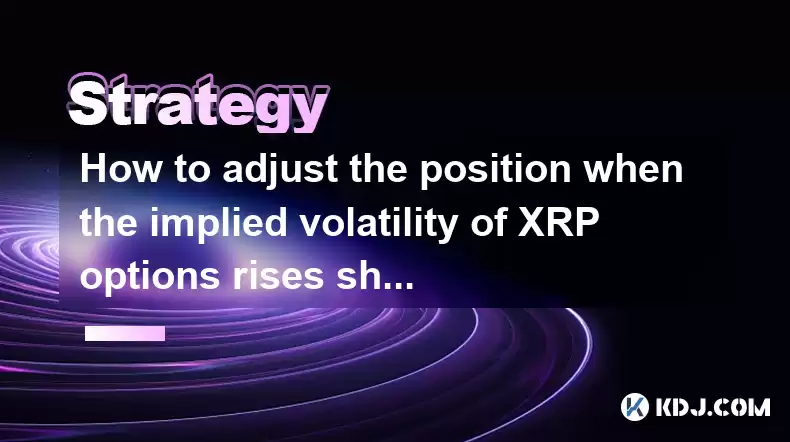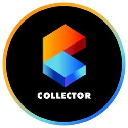-
 bitcoin
bitcoin $106975.071866 USD
-0.29% -
 ethereum
ethereum $3871.670850 USD
-0.07% -
 tether
tether $1.000261 USD
-0.01% -
 bnb
bnb $1084.417621 USD
-0.50% -
 xrp
xrp $2.348167 USD
0.82% -
 solana
solana $185.621736 USD
0.45% -
 usd-coin
usd-coin $0.999833 USD
-0.04% -
 tron
tron $0.313423 USD
0.81% -
 dogecoin
dogecoin $0.188856 USD
0.54% -
 cardano
cardano $0.630416 USD
-0.49% -
 hyperliquid
hyperliquid $36.506353 USD
2.24% -
 ethena-usde
ethena-usde $0.999584 USD
-0.01% -
 chainlink
chainlink $16.750026 USD
-0.77% -
 stellar
stellar $0.313373 USD
0.37% -
 bitcoin-cash
bitcoin-cash $465.978560 USD
-1.57%
How to adjust the position when the implied volatility of XRP options rises sharply?
When XRP options' implied volatility spikes, adjust your positions by assessing market conditions, choosing strategies like holding or rolling, and maintaining emotional discipline.
Apr 26, 2025 at 05:01 pm

When the implied volatility of XRP options rises sharply, it can significantly impact the value and strategy of your positions. Adjusting your positions effectively in such scenarios requires a thorough understanding of options mechanics and strategic foresight. This article will guide you through the process of adjusting your XRP options positions when implied volatility spikes, helping you to mitigate risk and potentially capitalize on the situation.
Understanding Implied Volatility and Its Impact
Implied volatility (IV) is a critical factor in the pricing of options. It represents the market's forecast of a likely movement in the underlying asset's price. When IV rises sharply, it generally leads to an increase in option premiums, particularly for at-the-money (ATM) and out-of-the-money (OTM) options. This can affect both long and short positions differently.
For long option holders, a rise in IV can be beneficial as the value of their options increases. However, for short option sellers, this can lead to potential losses as the options they sold become more expensive to buy back. Understanding these dynamics is crucial for making informed adjustments to your positions.
Assessing Your Current Position
Before making any adjustments, it's important to assess your current position thoroughly. Consider the following factors:
- Type of options: Are you holding calls or puts?
- Strike price: How far is your strike price from the current market price of XRP?
- Expiration date: How much time is left until your options expire?
- Current IV level: What is the current implied volatility compared to historical levels?
By understanding these elements, you can better determine the appropriate adjustments needed.
Strategies for Long Option Holders
If you are holding long options and IV rises sharply, you might consider the following strategies:
Hold the position: If you believe the underlying price of XRP will move significantly in your favor, holding onto your options could be beneficial. The increased IV will have already increased the value of your options, and any favorable price movement could further amplify your gains.
Sell part of the position: To lock in some profits from the IV spike, you might consider selling a portion of your long options. This can help you secure gains while still maintaining some exposure to potential future price movements.
Roll up or out: If you believe the price of XRP will continue to rise, you might consider rolling your options to a higher strike price (rolling up) or to a later expiration date (rolling out). This can help you maintain your position while potentially benefiting from further IV increases.
Strategies for Short Option Sellers
For those who have sold options and are facing a sharp rise in IV, consider the following strategies:
Buy back the options: If the rise in IV has significantly increased the value of the options you sold, buying them back at a higher price might be necessary to limit your losses. This can be costly but can prevent further potential losses if the IV continues to rise or if the underlying price moves against your position.
Implement a hedge: You can hedge your short position by buying options that offset your risk. For example, if you sold call options, you might buy call options at a higher strike price to limit your potential losses.
Adjust the delta: If you are managing a delta-neutral position, you might need to adjust your underlying XRP holdings to maintain the delta-neutral status. This can involve buying or selling XRP to counteract the changes in your options' delta caused by the IV spike.
Implementing Adjustments: Step-by-Step Guide
When you decide to adjust your position, follow these steps carefully:
Evaluate the market conditions: Before making any moves, reassess the current market conditions, including the price of XRP, the overall market sentiment, and any news that might affect XRP's price.
Choose your strategy: Based on your assessment, decide which strategy from the ones mentioned above best suits your situation.
Execute the trade:
- If you decide to hold your position, simply monitor the market and your position closely.
- If you choose to sell part of your position, go to your trading platform and execute a sell order for the desired number of options.
- If you decide to roll up or out, you will need to close your current position and open a new one with the new strike price or expiration date. This involves:
- Selling your current options.
- Buying new options with the desired strike price or expiration date.
- If you need to buy back options you sold, execute a buy-to-close order on your trading platform.
- For hedging, buy the appropriate options to offset your risk.
- To adjust the delta, buy or sell XRP accordingly on your trading platform.
Monitor and reassess: After making your adjustments, continue to monitor the market and your position. Be prepared to make further adjustments if necessary.
Managing Risk and Emotional Discipline
Adjusting positions when IV rises sharply can be stressful. It's crucial to maintain emotional discipline and stick to your risk management plan. Here are some tips:
- Set stop-loss orders: Use stop-loss orders to automatically close positions if they move against you beyond a certain point.
- Diversify your portfolio: Ensure that your portfolio is diversified to reduce the impact of any single position.
- Stay informed: Keep up with market news and developments that could affect XRP and the broader cryptocurrency market.
Frequently Asked Questions
Q: Can implied volatility continue to rise indefinitely?A: No, implied volatility cannot rise indefinitely. It tends to revert to its mean over time. However, during periods of high market uncertainty or significant news events, IV can remain elevated for extended periods.
Q: How does historical volatility relate to implied volatility?A: Historical volatility measures the actual price movements of an asset over a past period, while implied volatility is a forward-looking measure based on the market's expectation of future volatility. Both are important for understanding the potential risks and rewards of an options position.
Q: What are the tax implications of adjusting options positions?A: The tax implications of adjusting options positions can vary depending on your jurisdiction and the specifics of your trades. Generally, selling options or closing positions can trigger capital gains or losses. It's advisable to consult with a tax professional to understand the specific implications for your situation.
Q: How can I predict when implied volatility might rise?A: Predicting IV spikes can be challenging, but you can monitor factors such as upcoming events (like regulatory announcements or major product launches), market sentiment, and historical IV patterns. Tools like the VIX for broader market volatility can also provide insights into potential IV movements.
Disclaimer:info@kdj.com
The information provided is not trading advice. kdj.com does not assume any responsibility for any investments made based on the information provided in this article. Cryptocurrencies are highly volatile and it is highly recommended that you invest with caution after thorough research!
If you believe that the content used on this website infringes your copyright, please contact us immediately (info@kdj.com) and we will delete it promptly.
- OpenSea's SEA Token: A Bold Buyback Program Signals a New Era
- 2025-10-19 14:25:16
- Pi Coin's App Studio Upgrade: AI, Staking, and Utility Expansion
- 2025-10-19 14:25:16
- Bitcoin at $100K? Or Doomed? A New York Minute on Crypto's Wild Ride
- 2025-10-19 14:45:11
- XRP, Treasury Plan, and ETF Uncertainty: A Deep Dive
- 2025-10-19 14:45:11
- Crypto Trading Decoded: Technical Analysis, Regulation Influence, and Navigating the Tides
- 2025-10-19 14:30:16
- Pi Network's Global Visibility: Pinned to the Top in the Cryptocurrency World
- 2025-10-19 14:30:16
Related knowledge

Practical parameter settings for a Bitcoin multi-timeframe moving average system
Sep 18,2025 at 10:54pm
Optimizing Timeframe Combinations for Bitcoin Trading1. Selecting appropriate timeframes is crucial when building a multi-timeframe moving average sys...

How can I filter out false breakouts in Dogecoin high-frequency trading?
Sep 22,2025 at 01:00am
Understanding False Breakouts in Dogecoin Trading1. A false breakout occurs when Dogecoin's price appears to move beyond a defined support or resistan...

Techniques for identifying tops and bottoms in the Bitcoin on-chain NVT model
Sep 20,2025 at 07:54pm
Understanding the NVT Model in Bitcoin Analysis1. The Network Value to Transactions (NVT) ratio is often described as the 'P/E ratio' of the cryptocur...

What does the surge in open interest in Bitcoincoin futures mean?
Sep 20,2025 at 11:18pm
Understanding the Surge in Dogecoin Futures Open Interest1. A surge in open interest within Dogecoin futures indicates a growing number of active cont...

How can I use the Ethereum USDT premium to gauge market sentiment?
Sep 18,2025 at 11:55pm
Understanding the Ethereum USDT Premium1. The Ethereum USDT premium refers to the price difference between USDT (Tether) traded on Ethereum-based plat...

What should I do if Ethereum staking yields decline?
Sep 20,2025 at 06:18am
Understanding the Causes Behind Declining Ethereum Staking Yields1. The Ethereum network transitioned to a proof-of-stake consensus mechanism with the...

Practical parameter settings for a Bitcoin multi-timeframe moving average system
Sep 18,2025 at 10:54pm
Optimizing Timeframe Combinations for Bitcoin Trading1. Selecting appropriate timeframes is crucial when building a multi-timeframe moving average sys...

How can I filter out false breakouts in Dogecoin high-frequency trading?
Sep 22,2025 at 01:00am
Understanding False Breakouts in Dogecoin Trading1. A false breakout occurs when Dogecoin's price appears to move beyond a defined support or resistan...

Techniques for identifying tops and bottoms in the Bitcoin on-chain NVT model
Sep 20,2025 at 07:54pm
Understanding the NVT Model in Bitcoin Analysis1. The Network Value to Transactions (NVT) ratio is often described as the 'P/E ratio' of the cryptocur...

What does the surge in open interest in Bitcoincoin futures mean?
Sep 20,2025 at 11:18pm
Understanding the Surge in Dogecoin Futures Open Interest1. A surge in open interest within Dogecoin futures indicates a growing number of active cont...

How can I use the Ethereum USDT premium to gauge market sentiment?
Sep 18,2025 at 11:55pm
Understanding the Ethereum USDT Premium1. The Ethereum USDT premium refers to the price difference between USDT (Tether) traded on Ethereum-based plat...

What should I do if Ethereum staking yields decline?
Sep 20,2025 at 06:18am
Understanding the Causes Behind Declining Ethereum Staking Yields1. The Ethereum network transitioned to a proof-of-stake consensus mechanism with the...
See all articles





















![[4K 60fps] Astral by oc3andark (1 Coin) [4K 60fps] Astral by oc3andark (1 Coin)](/uploads/2025/10/19/cryptocurrencies-news/videos/k-fps-astral-ocandark-coin/68f438453fa33_image_500_375.webp)




















































